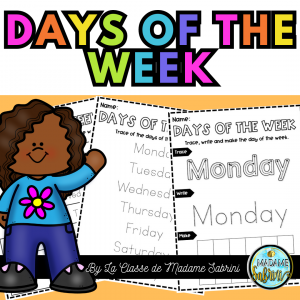This post may contain affiliate links which means I may receive a commission for purchases made through links. I will only recommend products that I have personally used! Learn more on my Private Policy page.
Starting the first week of lesson plan for kindergartens is a daunting task. It is important to get off on the right foot and provide an engaging and enjoyable learning experience. In this blog post, we will be discussing tips for planning the best first week of kindergarten lessons that will set your students up for success. From how to plan activities that are developmentally appropriate to ensuring students build positive relationships, these tips will help ensure your kindergartners have a great start to their school year.
Preparing for the First Week
The first week of kindergarten can be both exciting and nerve-wracking for both teachers and students. As a teacher, it’s crucial to have a well-thought-out plan in place to ensure a smooth and successful start to the school year. Here are some tips to help you prepare for the first week of kindergarten.
First and foremost, familiarize yourself with the curriculum and standards for kindergarten. This will give you a clear understanding of what skills and concepts your students should be learning throughout the year. Take the time to review the curriculum documents and gather any necessary materials or resources you may need.
Next, create a welcoming and organized classroom environment. Arrange furniture in a way that promotes collaboration and exploration. Set up learning centers and make sure all materials are easily accessible. Label everything, from cubbies to supplies, to help students find what they need independently.
Consider developing a daily schedule that includes both structured and unstructured activities. Kindergarteners thrive on routines, so having a consistent schedule will help them feel safe and secure. Incorporate time for whole-group instruction, small-group activities, and individual work. Be sure to include ample time for play and socialization, as this is an essential part of early childhood development.
In addition to preparing your physical space, it’s essential to mentally prepare yourself for the first week. Reflect on your teaching practices and consider how you can adapt them to meet the needs of your incoming kindergartners. Plan engaging and age-appropriate lessons that will capture their attention and promote active learning.
Finally, don’t forget to take care of yourself. The first week of kindergarten can be tiring and overwhelming, so make sure to prioritize self-care. Get enough sleep, eat nutritious meals, and take breaks when needed. Remember, you can’t pour from an empty cup, so take care of yourself to better care for your students.

Building Relationships with Students
Building strong relationships with your kindergartners is essential for creating a positive and inclusive learning environment. During the first week of school, focus on building trust and establishing connections with each of your students. This will not only make them feel safe and comfortable but also foster a sense of belonging and ownership in the classroom.
One effective way to build relationships with your kindergartners is through personal conversations. Take the time to have one-on-one conversations with each student, asking them about their interests, hobbies, and favorite things. This will show them that you genuinely care about getting to know them as individuals.
Another great way to build relationships is through fun and engaging activities. Plan activities that encourage collaboration, teamwork, and communication. This could be a class game, a group art project, or even a fun get-to-know-you activity. By participating in these activities together, your students will not only get to know each other but also see you as a facilitator of fun and learning.
Additionally, show kindness and empathy towards your students. Celebrate their successes, big or small, and offer support and understanding when they face challenges. Be patient and listen attentively when they share their thoughts and feelings. By demonstrating empathy and kindness, you are laying the foundation for a trusting relationship with your students.

Establishing Classroom Rules and Procedures
Setting clear and consistent rules and procedures is crucial for creating a positive and structured learning environment in your kindergarten classroom. During the first week of school, take the time to introduce and explain these rules to your students in a way that is age-appropriate and engaging.
Start by brainstorming a list of rules together as a class. This gives students a sense of ownership and responsibility in creating the rules. Keep the list short and simple, using language that is easy for kindergartners to understand. For example, “Be kind to others” or “Raise your hand to speak”.
Once you have established the rules, explain the consequences for not following them. It’s important to be clear and consistent with these consequences, but also fair and reasonable. Make sure your students understand the connection between their actions and the consequences that will follow.
To help your kindergartners remember the rules, create visual cues such as posters or handouts that display the rules in a kid-friendly way. You can also use mnemonics or catchy phrases to help them remember each rule.
In addition to rules, establish procedures for various classroom routines. Teach your students how to line up, how to enter and exit the classroom, and how to transition between activities. Practice these procedures repeatedly until they become second nature for your students.
By establishing clear rules and procedures from the start, you are creating a structured and predictable learning environment where your kindergartners can thrive. Remember to be consistent, reinforce positive behavior, and model the behavior you expect from your students. With these strategies in place, you will create a classroom that promotes respect, responsibility, and a love for learning.
Engaging Lesson Plans and Activities
The first week of kindergarten is an exciting time for both students and teachers. It’s the perfect opportunity to capture your students’ attention and foster a love for learning. By planning engaging lesson plans and activities, you can create a positive and interactive classroom environment that will set the tone for the rest of the school year.
One way to create engaging lesson plans is to incorporate hands-on activities and interactive games. Kindergarteners learn best through play, so incorporating activities that allow them to explore, create, and problem-solve will keep them actively engaged. For example, you can set up a sensory table where students can explore different textures or create a dramatic play area where they can act out stories.
Another way to engage your kindergarteners is by incorporating technology into your lessons. Use educational apps, interactive websites, or even simple video clips to enhance their learning experience. For example, you can use an interactive whiteboard to play educational games or show animated videos that teach important concepts.
In addition to hands-on activities and technology, consider incorporating movement and music into your lesson plans. Kindergarteners have a lot of energy, so allowing them to move and dance while learning will keep them engaged. Incorporate songs and chants that reinforce important concepts, such as counting or letter recognition.
Lastly, don’t be afraid to get creative with your lesson plans. Use props, costumes, or puppets to make learning more exciting. Consider themed lessons or projects that allow students to immerse themselves in a specific topic. The more you can make learning fun and interactive, the more engaged and motivated your kindergarteners will be.
Remember, the first week of kindergarten sets the foundation for the rest of the year. By planning engaging lesson plans and activities, you can create an environment where students are excited to learn and eager to participate. So, let your imagination run wild and make the first week of kindergarten a memorable and engaging experience for your students.
Assessing Student Learning and Progress
Assessing student learning and progress is a crucial part of the first week of kindergarten. It allows you, as the teacher, to gather valuable information about your students’ strengths and areas for growth. By assessing their learning, you can tailor your instruction to meet their individual needs and provide appropriate support and challenges.
One effective way to assess student learning in kindergarten is through informal observations. Take the time to observe your students during different activities and note their level of understanding and engagement. Watch for signs of active participation, problem-solving skills, and comprehension. This can be done through observing them during independent work time, small-group activities, or even during play.
Another method of assessment is through informal assessments. These can be quick check-ins, such as asking students to show a thumbs up or thumbs down to indicate their understanding of a concept. You can also use informal assessments like exit tickets or mini quizzes to gauge their comprehension. These quick assessments provide you with immediate feedback and allow you to adjust your instruction accordingly.
Additionally, consider incorporating formative assessments into your first-week lessons. These can be more structured assessments, such as individual tasks or group projects, that allow you to assess students’ understanding of specific skills or concepts. These assessments can provide more detailed information about their learning progress and help guide your future instruction.

















